平板矩形大开孔结构补强设计及效果研究
大尺度矩形开孔钢梁受力性能及设计方法研究的开题报告

大尺度矩形开孔钢梁受力性能及设计方法研究的开题报告一、研究背景随着建筑结构的大型化及多样化,大尺度矩形开孔钢梁的应用日趋广泛。
这种结构形式具有一定的美学效果,同时能够提高建筑结构的空间利用率。
然而,由于矩形开孔的存在,其受力性能与传统的实心钢梁存在一定的差异,需要对其受力性能进行研究和设计。
二、研究内容1.大尺度矩形开孔钢梁的受力性能分析:通过对大尺度矩形开孔钢梁的应力分析,探究矩形开孔对钢梁刚度和承载能力的影响。
2.大尺度矩形开孔钢梁的设计方法研究:根据上述分析结果,提出适合大尺度矩形开孔钢梁设计的方法,包括受力性能参数的确定、钢梁截面的设计等。
3.大尺度矩形开孔钢梁的实验研究:通过实验对设计方法的验证和对矩形开孔钢梁的性能进行进一步研究。
三、研究意义大尺度矩形开孔钢梁的研究具有重要的理论和实际意义。
一方面,该研究可以深入了解大尺度矩形开孔钢梁的力学性能和刚度特点,为其应用提供理论基础和技术支持;另一方面,该研究可以推进钢结构设计的发展,丰富了钢结构的设计方法,提高了钢结构的使用效益。
四、研究方法本研究将采用理论分析和实验相结合的方法,首先通过理论计算矩形开孔钢梁的受力性能,然后利用有限元软件对其进行仿真计算,最后进行实验验证。
在设计方法研究方面,本研究将采用优化设计的思想,通过不断修改和优化,提出适合大尺度矩形开孔钢梁的设计方法和约束条件。
五、研究计划第一年:对大尺度矩形开孔钢梁的受力性能进行分析和计算,提出初步的设计方案。
第二年:优化设计方案,通过有限元软件模拟分析和实验验证,进一步验证设计方案的有效性。
第三年:根据前期研究成果,完善设计方法,编写成果报告和论文,开展技术交流活动。
六、预期成果1.获得大尺度矩形开孔钢梁的受力性能数据和其对钢梁承载能力的影响规律。
2.提出适合大尺度矩形开孔钢梁设计的方法和设计要求,为工程实际应用提供支持和指导。
3.完成论文和成果报告,具有学术和实用价值,对钢结构领域的发展和应用具有重要意义。
平盖开孔的有限元分析及其补强方法的探讨
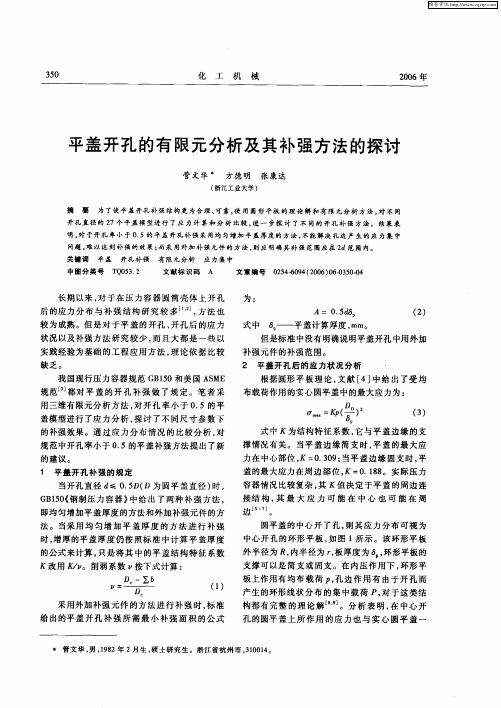
板上作 用有 均 布 载 荷 P 孔边 作用 有 由 于开 孔 而 ,
产生 的环形线 状 分 布 的集 中载 荷 P, 于 这类 结 对
采用 外加 补强 元 件 的方法 进 行 补强 时 , 准 标 给 出的平 盖 开孔 补 强 所 需 最 小 补 强 面 积 的 公式
构都 有完 整 的理 论 解 ] 。分 析 表 明 , 中心 开 在
时, 增厚的平盖厚度仍按照标准 中计算平盖厚度 的公式来计算, 只是将其 中的平盖结构特征系数
改用 。 削弱系数 1按下 式计算 : 1
=— 一 =— — ‘J ㈩ l
外半 径为 R, 内半 径为 r板 厚度 为 6 , , 环形 平板 的
支撑 可 以是 简 支 或 固支 。在 内压 作 用 下 , 环形 平
力集 中系数 为 2 0 .。
3 有 限元分 析的 结果
为 了便 于分 析 , 圆筒 与 平 盖 直接 焊 接 的结 用
构进行 计算 。建 模 时 , 文 采 用 1 4轴 对 称 结 构 本 / 进行有 限元 分析 计算 。 图 3是 中心 开孔 圆平 盖及 其筒体 的模 型 与 网格 。平 盖 采 用 Pae 2面单 元 l 4 n 和 Sl 4 o d 5体 单 元 , 体 采 用 Pa e2 面 单 元 和 i 筒 ln4
孔 的圆平 盖 上所 作 用 的 应 力 也 与 实 心 圆平 盖 一
管 文 华 , ,9 2年 2月 生 , 士研 究 生 。浙 江 省 杭 州 市 ,104 男 18 硕 30 1 。
维普资讯
第3 3卷
第 6期
化
工
机
械
31 5
样 , 由环 向和 径 向弯矩 引起 的两 向弯 曲应 力 。 是
压力容器大开孔补强工程设计方法
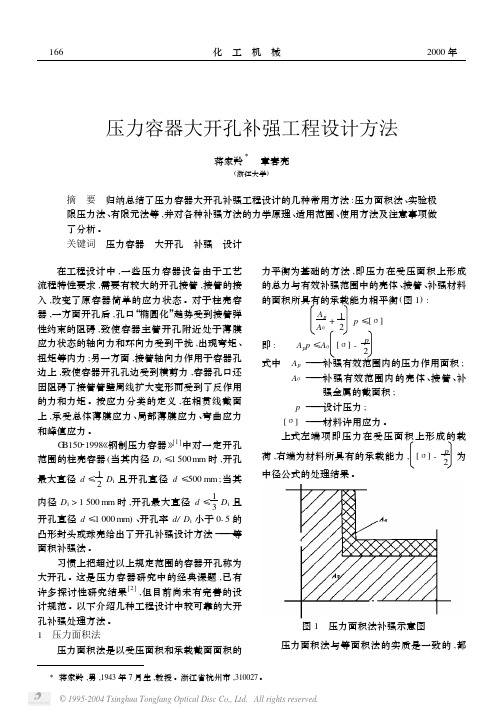
许多探讨性研究结果[2] ,但目前尚未有完善的设
计规范 。以下介绍几种工程设计中较可靠的大开
孔补强处理方法 。
1 压力面积法
压力面积法是以受压面积和承载截面面积的
力平衡为基础的方法 ,即压力在受压面积上形成 的总力与有效补强范围中的壳体 、接管 、补强材料 的面积所具有的承载能力相平衡 (图 1) :
由此对于较大的开孔 ,压力面积法的有效补 强范围取的较小 ,要求附加的补强面积相对较多 , 且较靠近开孔边缘 ,降低了局部应力集中水平 ,局 部应力引起的安全性问题相对缓和 ,故一般可用 于开孔率较大的场合[3] 。
采用压力面积法最早的是前西德 AD 压力容 器规范[4] ,法国在其标准 CODAP21987《非直接火 受压容器建造规范》[5]中也采用该开孔补强方法 。 1989 年原化工部在制定《钢制化工容器强度计算 规定》[6]中引入了压力面积法 ,允许使用开孔率不 大于 018 的大开孔场合 ,该标准还结合我国压力 容器用材 、制造及检验状况 ,提出应满足或注意的 5 个条件 :
R
C/ T -
C
和 d/ ( Di + T - C1 - C2) ( T - C1 - C2) 的关系曲 线 ,采用试差法求得筒体补强所要求壁厚 。该方
法的适用范围与压力面积法基本一致 。
3 有限元法
到目前为止 ,已有大量的开孔接管分析借助
有限元法完成 。柱壳 、球壳的开孔接管有限元分
析已有专用软件 ,一般只需输入容器与接管的特
c . 为确保焊接质量 ,接管 、壳体和补强件之 间的焊缝应进行无损探伤 。
d. 不宜用于介质对应力敏感的场合 。 e. 不宜用于可产生蠕变或有脉动载荷的场 合。 2 实验极限压力法 实验极 限 压 力 法 是 根 据 塑 性 失 效 准 则 的 观 点 ,即假设材料特性为弹性2理想塑性 (无应变硬 化) ,结构在相当多的部分发生屈服前不产生大量 变形 ,且不考虑残余应力对结构的影响 。当加载 时 ,最初材料呈弹性变形 ,随着载荷继续增加 ,将 在某处产生屈服 ,当载荷进一步增加时 ,屈服区便
开孔补强设计在常规压力容器制造中的应用

开孔补强设计在常规压力容器制造中的应用【摘要】在压力容器上开孔,将会使压力容器的承压能力降低,在其设计工艺条件下会产生危险,因此压力容器开孔后需进行补强,本文介绍了压力容易开孔补强的两种方法和应注意的问题,并针对实例进行了计算演示。
【关键词】压力容器补强开孔随着化工行业的发展,压力容器在化工厂中越来越普遍,其安全性也越来越受到重视。
开孔补强设计是压力容器设计中必不可少的一部分,标准和规范中虽然对设计和计算都作了较为详细的规定,但安全、经济、合理的设计仍是摆在我们面前的一个课题。
一旦计算有误就会造成容器的破坏,甚至引起工作人员的伤害,或者造成经济上的浪费。
按照gb150.1~gb150.4-2011《压力容器》规定,在压力容器的设计过程中,应采用适当的开孔补强设计。
下面就对压力容器的开孔补强进行分析。
1 开孔补强方法的选择1.1 压力面积法压力面积是西德ad规范中采用的开孔补强方法,其开孔率可达0.8,较等面积法为大。
当开孔率超出等面积法适用范围时,常采用该法进行补强:压力面积法的意义如下。
式中,ap—为补强有效范围内的压力作用面积;aσ—为补强有效范围内的壳体、接管、补强金属的截面积;p—设计压力;[σ]—材料许用应力公式(1)是以在壳体有效补强区域中的压力载荷与壳体的承载能力相平衡为基础的,即压力在壳体受压面积上形成的载荷与有效补强范围中的壳体、接管、补强材料的面积所具有的承载能力相平衡。
由式(1)的变形得出式(式2):式中左端项即压力在壳体受压面积上形成的载荷。
式中右端项为材料所具有的承载能力材料的承载能力,应大于压力引起的载荷,所以使用不等号相联接。
1.2 等面积补强法等面积法是以拉伸的开孔大平板为计算模型的。
但随着壳体开孔直径增大,开孔边缘不仅存在很大的薄膜应力,而且还产生很高的弯曲应力,故该方法不能相适应。
等面积法是壳体截面因开孔被削弱的承载面积,需有补强材料予以等面积补偿,其实质是壳体截面因开孔丧失的强度,即被削弱的承载面积a乘以壳体材料在设计温度下的许用应力[σ]t,即a·[σ]t,由补强材料予以补偿,当补强材料与壳体材料相同时,补强面积等于削弱的面积,故称等面积法。
平板开孔及矩形容器应力和结构的分析研究的开题报告
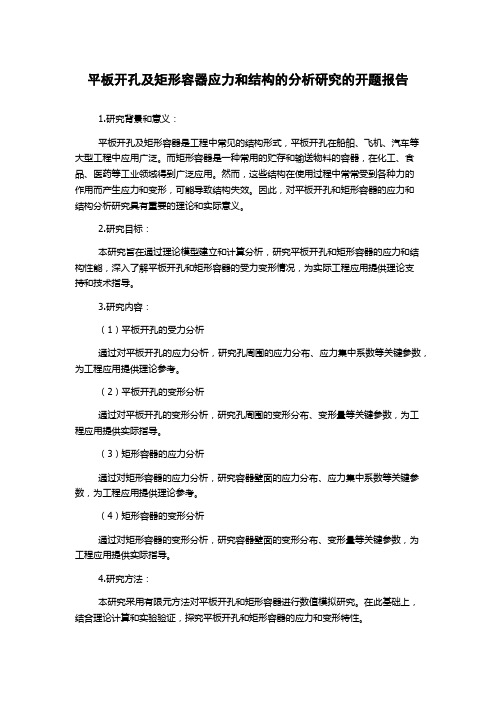
平板开孔及矩形容器应力和结构的分析研究的开题报告1.研究背景和意义:平板开孔及矩形容器是工程中常见的结构形式,平板开孔在船舶、飞机、汽车等大型工程中应用广泛。
而矩形容器是一种常用的贮存和输送物料的容器,在化工、食品、医药等工业领域得到广泛应用。
然而,这些结构在使用过程中常常受到各种力的作用而产生应力和变形,可能导致结构失效。
因此,对平板开孔和矩形容器的应力和结构分析研究具有重要的理论和实际意义。
2.研究目标:本研究旨在通过理论模型建立和计算分析,研究平板开孔和矩形容器的应力和结构性能,深入了解平板开孔和矩形容器的受力变形情况,为实际工程应用提供理论支持和技术指导。
3.研究内容:(1)平板开孔的受力分析通过对平板开孔的应力分析,研究孔周围的应力分布、应力集中系数等关键参数,为工程应用提供理论参考。
(2)平板开孔的变形分析通过对平板开孔的变形分析,研究孔周围的变形分布、变形量等关键参数,为工程应用提供实际指导。
(3)矩形容器的应力分析通过对矩形容器的应力分析,研究容器壁面的应力分布、应力集中系数等关键参数,为工程应用提供理论参考。
(4)矩形容器的变形分析通过对矩形容器的变形分析,研究容器壁面的变形分布、变形量等关键参数,为工程应用提供实际指导。
4.研究方法:本研究采用有限元方法对平板开孔和矩形容器进行数值模拟研究。
在此基础上,结合理论计算和实验验证,探究平板开孔和矩形容器的应力和变形特性。
5.预期成果:本研究期望得到以下成果:(1)建立平板开孔和矩形容器的理论模型和数值模拟方法;(2)分析平板开孔和矩形容器的应力和变形特性,深入研究其受力机理;(3)提出针对平板开孔和矩形容器结构的优化设计方法;(4)为实际工程提供理论参考和实际指导。
压力容器零部件设计---3开孔补强

开孔接管部位的应力集中
★器壁强度削弱:开孔造成局部应力集中和强
度削弱;
★不连续应力:壳体与接管形成结构曲率不
连续,产生较大的附加弯曲应力;
★局部应力:壳体与接管拐角处不等截面
过渡,引起很高的局部附加应力。
★焊接缺陷和残余应力
峰值应力
容器大开孔与小开孔
容器孔边应力集中的理论分析是以无限大平板上开 小圆孔为基础的,壳体曲率变化不计,因此,孔边 应力均为拉(压)应力。
边集中应力、薄膜应力外,还有
边缘应力和焊接应力,比小孔K
值高达3~6倍。应力集中具有
局部性。
• 开孔接管补强的目的:
•
使孔边的应力峰值降低
•
到允许值。
• 相关标准:HG/T21630
HGJ527-90 补强管
适用范围 两标准都规定了适用范围为当 量压力PD≤6.4MPa,共分A、B、C、D、E五 种。其中D、E型是削边过渡的,但其削边角 度是45度,而不是常规的1:3削边处理。
•
开孔计算直径d的取法(见下图):由于圆筒计算
厚度是根据周向薄膜应力计算的,因此开孔截面应以
承受周向薄膜应力的截面考虑,即是与圆筒轴线平行 的纵向截面。开孔计算直径d为孔沿纵截面方向的直径。
• 适用范围:
• 等面积补强:适用于开孔直径小于筒体内径 的一半。 即d/Di≤1/2 ;
• 压力面积法:(HG20582.7“大开孔的补强 计算”)适用于开孔直径小于筒体内径的 0.8倍。即d/Di≤0.8;(但注意五个限制条件)
大开孔时,除有拉(压)应力外,还有很大的弯曲 应力,其应力范围超出了开小孔时的局部范围,在 较大范围内破坏了壳体的薄膜应力状态。因此小开 孔理论不适用。
4.3.5开孔和开孔补强设计
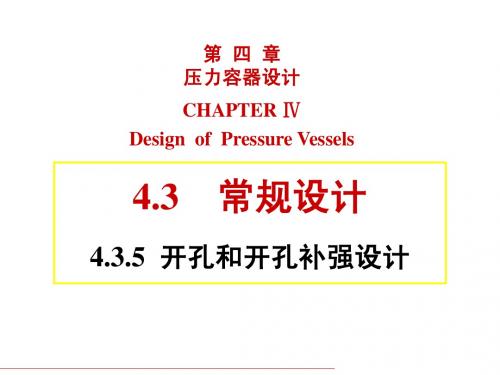
4.3.5 开孔和开孔补强设计
过程设备设计
厚壁接管补强
4.3.5 开孔和开孔补强设计
过程设备设计
(3)整锻件补强
整体锻件
图4-37 (c)整锻件补强
4.3.5 开孔和开孔补强设计
过程设备设计
整锻件补强
4.3.5 开孔和开孔补强设计
过程设备设计
结构
将接管和部分壳体连同补强部分做成整体锻件,再与 壳体和接管焊接,见(c)图。
问题:没有考虑开孔处应力集中的 影响,没有计入容器直径变化的影 响,补强后对不同接管会得到不同 的应力集中系数,即安全裕量不同, 因此有时显得富裕,有时显得不足。
原理:以双向受拉伸的无限 大平板上开有小孔时孔边的 应力集中作为理论基础的, 即仅考虑壳体中存在的拉伸 薄膜应力,且以补强壳体的 一次应力强度作为设计准则。 故对小直径的开孔安全可靠。
截面积仅为因开孔而引起削弱截面积的一半。
外压圆筒或球壳:
A 0.5[d 2 et (1 f r )]
平盖开孔直径d≤0.5Di:
(4-77)
A 0.5d p
式中 δp—平盖计算厚度,mm。
(4-78)
4.3.5 开孔和开孔补强设计
过程设备设计
(3)有效补强范围
在一定范围内 能起补强作用, 除了此范围, 则起不到补强 作用。 有效补强区: 矩形WXYZ, 见图4-38。
过程设备设计
削弱器壁的强度
开孔带来的问题 产生高的局部应力
4.3.5 开孔和开孔补强设计
过程设
4.3.5 开孔和开孔补强设计
过程设备设计
平板 开小孔
平板在两向拉力作用下,开小孔时孔边受力情况
4.3.5 开孔和开孔补强设计
CFRP补强(加固)钢筋混凝土开孔平板的试验研究
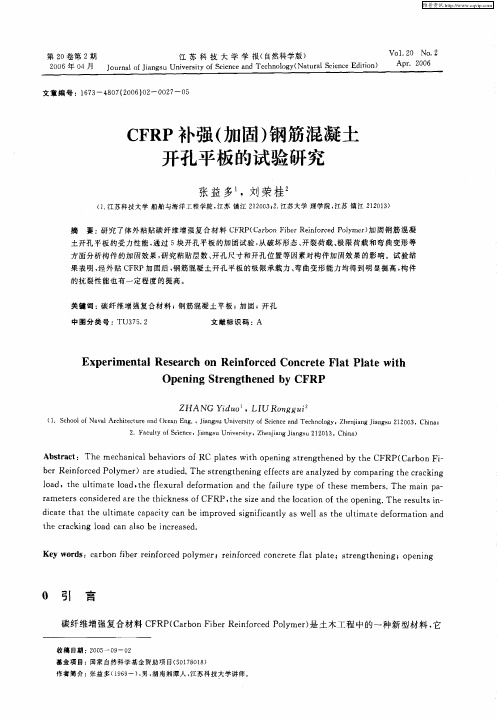
0 引 言
碳 纤维增 强复 合材料 C R ( ab nFbrR ifre oy r是 土 木工程 中的一 种新 型材料 , F P C ro ie enocdP lme) 它
摘
要 : 究 了 体外 粘 贴 碳 纤 维增 强复 合 材 料 C R C ro ie e fre oy e ) 固 钢 筋 混 凝 研 F P( ab nFbrR i ocdP lm r 加 n
土开孔平板的受力性能 , 通过 5 块开孑 平板的加固试验 , L 从破坏形态 、 开裂荷载 、 极限荷载和 弯曲变形等
.
r me e sc n ie e r h h c n s f a tr o sd rd a et et ik e so CFRP,h iea d t elc to f h p nn Th e U t — t esz n h o a ino eo e i g t er S Isi n
2 aut f c ne J n s ies y Z ej n i g u2 2 1 .C ia .F cl o i c , i g uUnv ri , h nl gJa s 1 0 hn ) y S e a t a n 3
A sr c : Th e h n clb h vo so lt swi p nn te g h n db h b ta t em c a ia e a ir fRC pa e t o e i gsr n t e e yt eCFRP( r o — h Ca b nFi b rRen o c dPoy e )a esu id Th te g h nn fe t r n lz db o p rn h r c ig e i fr e lm r r t de . esr n t e i ge fc sa ea a y e y c m a ig t ec a k n
球壳大开孔平齐接管补强设计方法评价
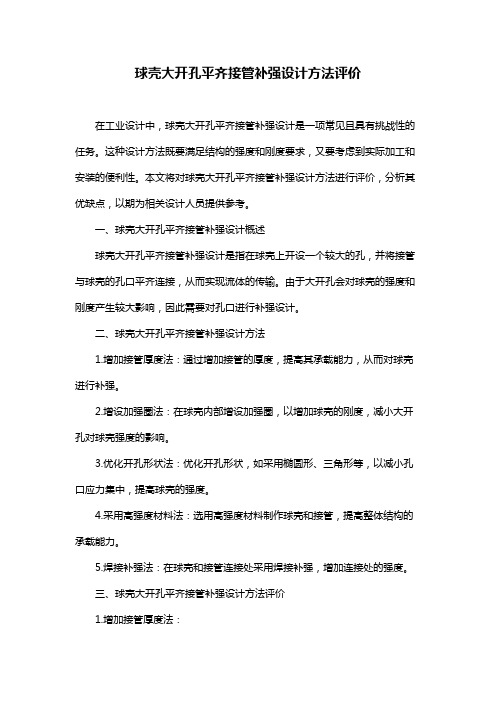
球壳大开孔平齐接管补强设计方法评价在工业设计中,球壳大开孔平齐接管补强设计是一项常见且具有挑战性的任务。
这种设计方法既要满足结构的强度和刚度要求,又要考虑到实际加工和安装的便利性。
本文将对球壳大开孔平齐接管补强设计方法进行评价,分析其优缺点,以期为相关设计人员提供参考。
一、球壳大开孔平齐接管补强设计概述球壳大开孔平齐接管补强设计是指在球壳上开设一个较大的孔,并将接管与球壳的孔口平齐连接,从而实现流体的传输。
由于大开孔会对球壳的强度和刚度产生较大影响,因此需要对孔口进行补强设计。
二、球壳大开孔平齐接管补强设计方法1.增加接管厚度法:通过增加接管的厚度,提高其承载能力,从而对球壳进行补强。
2.增设加强圈法:在球壳内部增设加强圈,以增加球壳的刚度,减小大开孔对球壳强度的影响。
3.优化开孔形状法:优化开孔形状,如采用椭圆形、三角形等,以减小孔口应力集中,提高球壳的强度。
4.采用高强度材料法:选用高强度材料制作球壳和接管,提高整体结构的承载能力。
5.焊接补强法:在球壳和接管连接处采用焊接补强,增加连接处的强度。
三、球壳大开孔平齐接管补强设计方法评价1.增加接管厚度法:优点:设计简单,易于实施。
缺点:增加接管厚度会增大流体的阻力,影响流体传输效率;同时,增加厚度可能导致接管与球壳连接处的应力集中。
2.增设加强圈法:优点:提高球壳的刚度,减小大开孔对球壳强度的影响。
缺点:增加加工难度,提高制造成本;同时,加强圈可能影响流体的流动。
3.优化开孔形状法:优点:减小孔口应力集中,提高球壳强度。
缺点:设计复杂,加工难度较高。
4.采用高强度材料法:优点:提高整体结构的承载能力,减小球壳厚度,降低制造成本。
缺点:高强度材料成本较高,可能导致制造成本上升。
5.焊接补强法:优点:提高连接处的强度,确保结构安全。
缺点:焊接过程可能影响球壳和接管的材料性能,导致结构疲劳寿命降低。
四、总结球壳大开孔平齐接管补强设计方法多种多样,各有优缺点。
大开孔补强的参数化分析设计
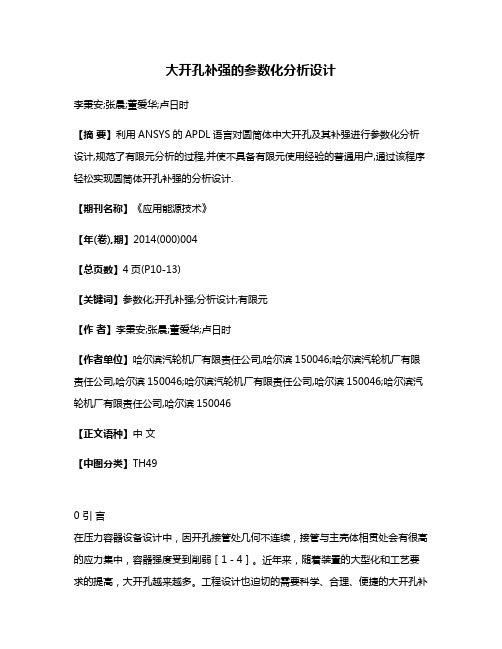
大开孔补强的参数化分析设计李秉安;张晨;董爱华;卢日时【摘要】利用ANSYS的APDL语言对圆筒体中大开孔及其补强进行参数化分析设计,规范了有限元分析的过程,并使不具备有限元使用经验的普通用户,通过该程序轻松实现圆筒体开孔补强的分析设计.【期刊名称】《应用能源技术》【年(卷),期】2014(000)004【总页数】4页(P10-13)【关键词】参数化;开孔补强;分析设计;有限元【作者】李秉安;张晨;董爱华;卢日时【作者单位】哈尔滨汽轮机厂有限责任公司,哈尔滨150046;哈尔滨汽轮机厂有限责任公司,哈尔滨150046;哈尔滨汽轮机厂有限责任公司,哈尔滨150046;哈尔滨汽轮机厂有限责任公司,哈尔滨150046【正文语种】中文【中图分类】TH490 引言在压力容器设备设计中,因开孔接管处几何不连续,接管与主壳体相贯处会有很高的应力集中,容器强度受到削弱[1-4]。
近年来,随着装置的大型化和工艺要求的提高,大开孔越来越多。
工程设计也迫切的需要科学、合理、便捷的大开孔补强计算方法[5-8]。
我公司低压加热器抽汽口、海水淡化主蒸发器抽汽口等一系列设备的接口经常会遇到大开孔补强的问题,参数化的大开孔补强分析设计方法是解决这些问题高效可靠的手段[9-13]。
1 国内外开孔补强基本方法及其对比曾有多篇学术论文和专著中对开孔补强的方法,理论推演,适用范围做了详细论述,文中在此处做一小结(见表1)。
表1 几种开孔补强方法的比较计算方法标准使用范围理论来源等面积法GB150 ASMEⅧ-1等内外压、对d及D 的限制参见标准双向拉伸无限大平板开小孔的模型应力分析法 GB150 JB4732等内压、d≤0.9D,且 MAX[0.5,d/D]≤бet/бe≤2 圆柱壳径向接管开孔补强的薄壳理论解压力面积法 PD5500 HG2058等内外压、对d及D的限制参见标准开孔边缘应力只考虑了一次总体及局部薄膜应力续表1 几种开孔补强方法的比较计算方法标准使用范围理论来源膜-弯应力法ASMEⅧ-1等内外压、对d及D的限制参见标准在压力面积法的基础上增加弯曲应力的控制ASME另一方法ASMEⅧ-1等内外压、对d及D的限制参见标准限制开孔接管附近局部薄膜应力的方法弹性力学理论的数值解法,配以弹塑性强度分析设计法JB4732 ASMEⅧ -2 EN13445等内外压、对d及D没有要求准则上述六种开孔补强法,根据不同的理论来源,可分为两大类。
钢结构矩形开孔止裂孔

钢结构矩形开孔止裂孔
钢结构矩形开孔止裂孔是在应力容易集中的地方防止裂纹延伸的一种操作习惯。
一般情况,使用在各种板材、型材的边角,细小裂缝由外向里延伸的端部,例如两板甚至更多钢结构的焊缝两端附近的板材、钢结构倒过圆角的部分等。
止裂孔孔径一般取为板厚,止裂孔中心距裂缝尖端的距离取0.5至1倍的板厚,并且止裂孔的圆心位置应该位于裂缝扩展路径前方。
止裂孔法应该是各种疲劳裂缝修复方法中实施最简单的一种,但也是效果最差的之一。
以上内容仅供参考,如需更全面准确的信息,可以咨询资深的钢结构工程师。
同时,在操作过程中要严格遵守安全规范,确保止裂孔设置合理有效。
平板开洞方案
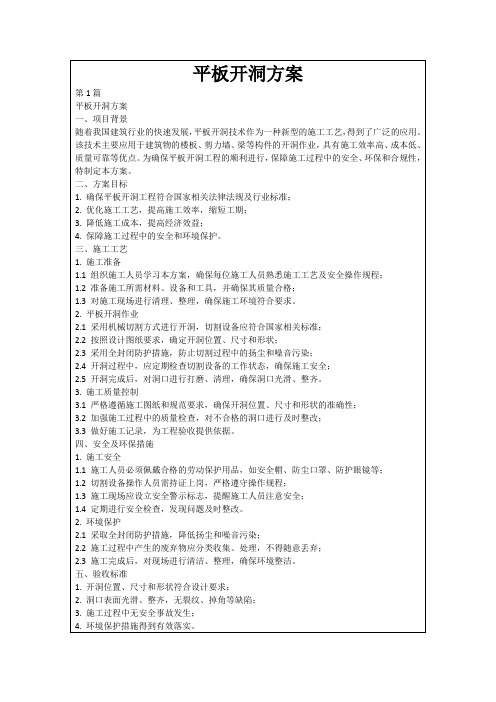
平板开洞方案
一、项目概述
平板开洞工程是在建筑物楼板、剪力墙等结构体系中进行的特定作业,旨在满足建筑功能需求与优化空间布局。为确保工程质量和施工安全,本方案将从施工准备、工艺流程、质量控制、安全环保及验收标准等方面进行系统阐述。
二、施工准备
1.技术准备
1.1组织技术人员熟悉施工图纸,掌握设计要求及规范标准;
1.3对施工现场进行清理、整理,确保施工环境符合要求。
2.平板开洞作业
2.1采用机械切割方式进行开洞,切割设备应符合国家相关标准;
2.2按照设计图纸要求,确定开洞位置、尺寸和形状;
2.3采用全封闭防护措施,防止切割过程中的扬尘和噪音污染;
2.4开洞过程中,应定期检查切割设备的工作状态,确保施工安全;
2.施工要点
2.1切割过程中,应严格控制切割速度和切割厚度,确保切割质量;
2.2定期检查切割设备,确保设备正常运行,防止施工安全事故;
2.3切割完成后,及时清理施工现场,确保施工环境整洁。
四、质量控制
1.质量标准
1.1开洞位置、尺寸、形状应符合设计要求;
1.2洞口表面应光滑、整齐,无裂纹、蜂窝等缺陷;
三、工艺流程
1.平板开洞作业流程
1.1测量定位:根据设计图纸,使用测量工具对开洞位置进行精确放样;
1.2划线标识:在楼板或剪力墙上划出开洞轮廓线,确保位置准确;
1.3切割施工:采用专业切割设备进行开洞作业,注意切割速度和冷却;
1.4清理修整:开洞完成后,对洞口进行清理、打磨,使其光滑、整齐;
1.5防护处理:对开洞边缘进行防护处理,防止混凝土破损、脱落。
平板开洞方案
第1篇
平板开洞方案
一、项目背景
随着我国建筑行业的快速发展,平板开洞技术作为一种新型的施工工艺,得到了广泛的应用。该技术主要应用于建筑物的楼板、剪力墙、梁等构件的开洞作业,具有施工效率高、成本低、质量可靠等优点。为确保平板开洞工程的顺利进行,保障施工过程中的安全、环保和合规性,特制定本方案。
孔边导角对开孔方形平板应力集中的理论解分析
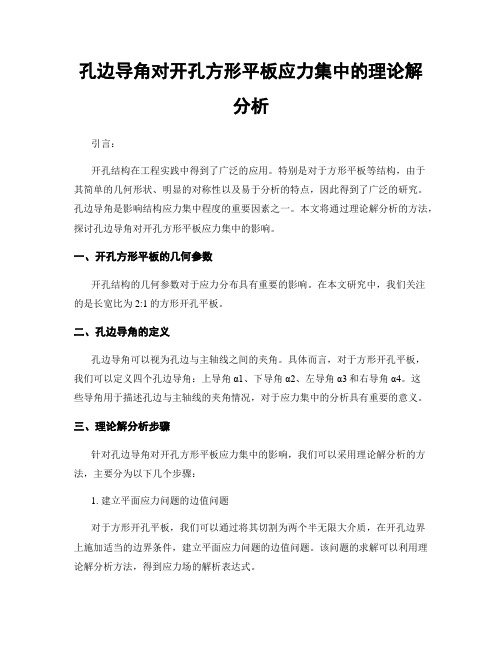
孔边导角对开孔方形平板应力集中的理论解分析引言:开孔结构在工程实践中得到了广泛的应用。
特别是对于方形平板等结构,由于其简单的几何形状、明显的对称性以及易于分析的特点,因此得到了广泛的研究。
孔边导角是影响结构应力集中程度的重要因素之一。
本文将通过理论解分析的方法,探讨孔边导角对开孔方形平板应力集中的影响。
一、开孔方形平板的几何参数开孔结构的几何参数对于应力分布具有重要的影响。
在本文研究中,我们关注的是长宽比为2:1的方形开孔平板。
二、孔边导角的定义孔边导角可以视为孔边与主轴线之间的夹角。
具体而言,对于方形开孔平板,我们可以定义四个孔边导角:上导角α1、下导角α2、左导角α3和右导角α4。
这些导角用于描述孔边与主轴线的夹角情况,对于应力集中的分析具有重要的意义。
三、理论解分析步骤针对孔边导角对开孔方形平板应力集中的影响,我们可以采用理论解分析的方法,主要分为以下几个步骤:1. 建立平面应力问题的边值问题对于方形开孔平板,我们可以通过将其切割为两个半无限大介质,在开孔边界上施加适当的边界条件,建立平面应力问题的边值问题。
该问题的求解可以利用理论解分析方法,得到应力场的解析表达式。
2. 应用边界条件求解应力分量通过在边值问题中应用边界条件,我们可以求解出应力分量的解析表达式。
根据孔边导角的不同,这些应力分量的解析表达式可能会有所不同。
3. 计算应力集中系数根据应力集中的定义,我们可以利用求解得到的应力分量解析表达式,计算出应力集中系数。
该系数可以量化应力集中的程度。
4. 分析孔边导角对应力集中的影响通过比较不同孔边导角情况下得到的应力集中系数,我们可以分析孔边导角对应力集中的影响。
不同导角之间的比较可以帮助我们理解孔边导角对应力集中的作用机理。
四、理论解分析的优势和应用理论解分析是一种基于数学模型和边界条件的分析方法,具有以下优势和应用价值:1. 理论解分析可以给出精确的数值结果,有助于深入理解结构的力学行为。
矩形大开孔对圆柱壳薄壁体系结构屈曲的影响及动力反应特性研究
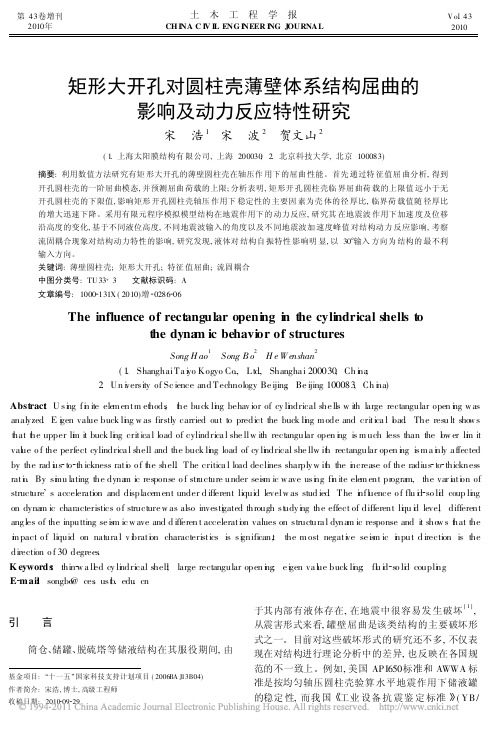
第43卷增刊2010年土 木 工 程 学 报CH I NA C I V I L ENG I NEER I NG J OURNALV o.l 432010基金项目: 十一五 国家科技支持计划项目(2006BA J 13B04)作者简介:宋浩,博士,高级工程师收稿日期:2010 09 29矩形大开孔对圆柱壳薄壁体系结构屈曲的影响及动力反应特性研究宋 浩1宋 波2贺文山2(1.上海太阳膜结构有限公司,上海200030;2.北京科技大学,北京100083)摘要:利用数值方法研究有矩形大开孔的薄壁圆柱壳在轴压作用下的屈曲性能。
首先通过特征值屈曲分析,得到开孔圆柱壳的一阶屈曲模态,并预测屈曲荷载的上限;分析表明,矩形开孔圆柱壳临界屈曲荷载的上限值远小于无开孔圆柱壳的下限值,影响矩形开孔圆柱壳轴压作用下稳定性的主要因素为壳体的径厚比,临界荷载值随径厚比的增大迅速下降。
采用有限元程序模拟模型结构在地震作用下的动力反应,研究其在地震波作用下加速度及位移沿高度的变化,基于不同液位高度,不同地震波输入的角度以及不同地震波加速度峰值对结构动力反应影响,考察流固耦合现象对结构动力特性的影响,研究发现,液体对结构自振特性影响明显,以30 输入方向为结构的最不利输入方向。
关键词:薄壁圆柱壳;矩形大开孔;特征值屈曲;流固耦合中图分类号:TU 33+3 文献标识码:A 文章编号:1000 131X (2010)增 0286 06The influence of rectangular openi ng i n the cyli ndrical shells tothe dyna m ic behavi or of structuresSong H ao 1Song B o 2H e W enshan2(1.ShanghaiTa i y o Kogyo Co .,Ltd .,Shangha i 200030,Ch i n a ;2.Un i v ersity of Sc ience and Technology Be ijing ,Be ijing 100083,Ch i n a)Abst ract :U si n g fi n ite ele m entm et h ods ,t h e buck li n g behav ior of cy li n drical she lls w ith large rectangular open i n g w asanalyzed .E i g en value buck li n g w as firstly carried out to predict the buck li n g m ode and critica l l o ad .The resu lt sho w s t h at t h e upper li m it buck li n g critica l load of cylindrica l she llw ith rectangular open i n g is m uch less than the l o w er li m it val u e o f the perfect cylindrica l shell and the buck li n g load of cy li n drical she llw it h rectangular open i n g ism a i n ly a ffected by the rad i u s to th ickness rati o o f t h e shel.l The critica l load declines sharply w it h the i n crease of the radius to thickness rati o .By si m u lating the dyna m ic response o f str ucture under seis m ic w ave usi n g fi n ite ele m ent pr ogra m,the var i a ti o n of structure s acceleration and displace m ent under d ifferent liquid levelw as stud ied .The i n fl u ence o f flu i d so li d coup li n g on dyna m ic characteristics o f structure w as also investi g ated through st u dy i n g the effect of different li q u i d leve,l different ang les of the inputting se is m ic w ave and d ifferen t accelerati o n values on structura l dyna m ic response and it sho w s t h at the im pact o f liquid on natura l v i b rati o n characteristics is si g nifican,t the m ost negati v e se is m ic i n put d irection is the direction o f 30degrees .K eywords :thin w a ll e d cy li n drical shel;l large rectangular open i n g ;e i g en va l u e buck li n g ;fl u i d so li d coupli n g E m ai:l songbo @ces .ust b .edu .cn引 言筒仓、储罐、脱硫塔等储液结构在其服役期间,由于其内部有液体存在,在地震中很容易发生破坏[1],从震害形式来看,罐壁屈曲是该类结构的主要破坏形式之一。
压力容器设计中开孔补强设计的应用研究
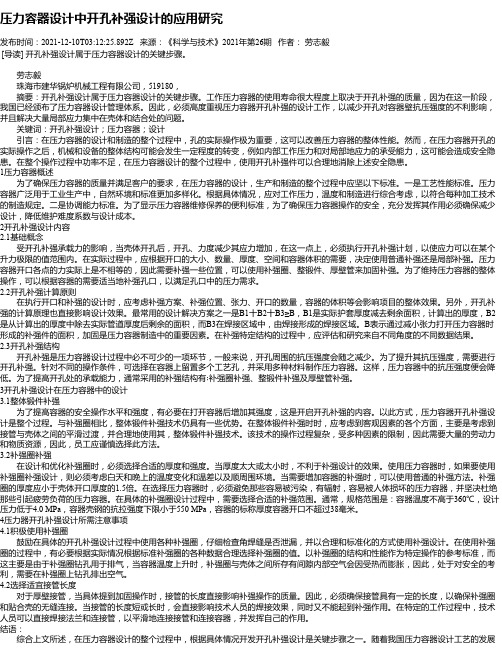
压力容器设计中开孔补强设计的应用研究发布时间:2021-12-10T03:12:25.892Z 来源:《科学与技术》2021年第26期作者:劳志毅[导读] 开孔补强设计属于压力容器设计的关键步骤。
劳志毅珠海市建华锅炉机械工程有限公司,519180,摘要:开孔补强设计属于压力容器设计的关键步骤。
工作压力容器的使用寿命很大程度上取决于开孔补强的质量,因为在这一阶段,我国已经颁布了压力容器设计管理体系。
因此,必须高度重视压力容器开孔补强的设计工作,以减少开孔对容器壁抗压强度的不利影响,并且解决大量局部应力集中在壳体和结合处的问题。
关键词:开孔补强设计;压力容器;设计引言:在压力容器的设计和制造的整个过程中,孔的实际操作极为重要,这可以改善压力容器的整体性能。
然而,在压力容器开孔的实际操作之后,机械和设备的整体结构可能会发生一定程度的转变,例如内部工作压力和对局部地应力的承受能力,这可能会造成安全隐患。
在整个操作过程中功率不足,在压力容器设计的整个过程中,使用开孔补强件可以合理地消除上述安全隐患。
1压力容器概述为了确保压力容器的质量并满足客户的要求,在压力容器的设计,生产和制造的整个过程中应坚以下标准。
一是工艺性能标准。
压力容器广泛用于工业生产中,自然环境和标准更加多样化。
根据具体情况,应对工作压力,温度和制造进行综合考虑,以符合每种加工技术的制造规定。
二是协调能力标准。
为了显示压力容器维修保养的便利标准,为了确保压力容器操作的安全,充分发挥其作用必须确保减少设计,降低维护难度系数与设计成本。
2开孔补强设计内容2.1基础概念受开孔补强承载力的影响,当壳体开孔后,开孔、力度减少其应力增加,在这一点上,必须执行开孔补强计划,以使应力可以在某个升力极限的值范围内。
在实际过程中,应根据开口的大小、数量、厚度、空间和容器体积的需要,决定使用普通补强还是局部补强。
压力容器开口各点的力实际上是不相等的,因此需要补强一些位置,可以使用补强圈、整锻件、厚壁管来加固补强。
开孔补强设计在压力容器设计中的应用探析

开孔补强设计在压力容器设计中的应用探析发布时间:2021-12-07T02:02:01.598Z 来源:《科学与技术》2021年第29卷第19期作者:张爱芹[导读] 当前我国对压力容器的安全质量方面已经制定了一系列的标准张爱芹扬州巨人机械有限公司江苏省扬州市225004摘要:当前我国对压力容器的安全质量方面已经制定了一系列的标准,因而需要压力容器的设计人员对于其开孔补强设计的开展具有充分的了解与把握。
局部补强和整体补强的开展各有其针对的情况,不能一味地肯定其中一种而否定另一种;在具体的开孔补强方法中,等面积补强法和压力面积补强法也从不同角度解决了压力容器开孔补强的问题,但鉴于二者都具有一定的局限性,所以开孔补强技术的不断优化仍是设计者们要考虑的问题。
关键词:开孔补强、压力容器、设计、应用1开孔补强概述1.1开孔补强结构在压力容器上实施开孔操作之后,为了能够使降低的开孔周围材质抗压强度得以提升而对其实施补救的这样一种方式就是所谓的开孔补强结构。
由于要满足不同的要求,采用同材质材料制作压力容器需要在外壁上将各种各样的小孔开出来,但是这样会降低压力容器的整体抗压强度,并且进一步导致压力容器在使用过程中发生各种问题,缩短压力容器的使用寿命。
要想使压力容器的整体强度得以维持,就必须要针对压力容器外壁所开小孔周围实施开孔补强技术处理。
在具体实施开孔补强技术的过程中需要综合考虑对容器的要求、开孔的数量、位置等各项因素,并且可以此为依据将开孔补强结构划分为两种,也就是局部补强和整体补强。
1.2开孔补强设计的公式在相关技术人员对容器开孔进行补强设计时,除了对补强方法、容器内部应力等的思考外,还应注意对补强设计的计算。
目前,补强设计所应用的计算方法主要是a+b+c≥d,在此公式中,a表示补强设计时的多余面积,a=容器壳体有效厚度-计算厚度。
b也是表示多余面积,与a不同的是,b=接管的有效厚度-计算厚度。
c表示补强区域焊接时的金属截面积。
压力容器设计中开孔补强设计的应用研究
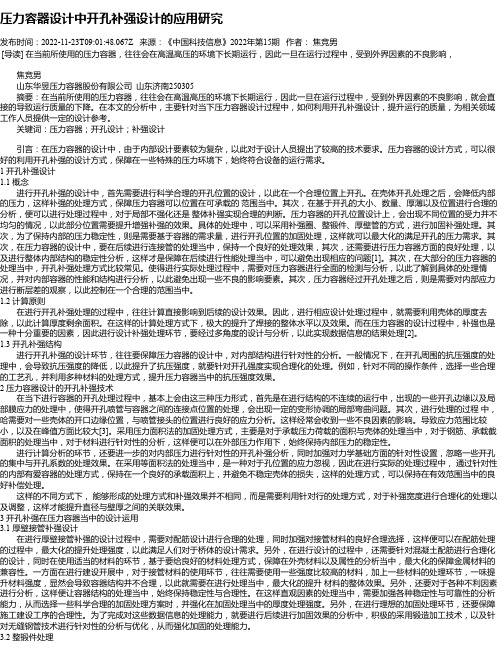
压力容器设计中开孔补强设计的应用研究发布时间:2022-11-23T09:01:48.067Z 来源:《中国科技信息》2022年第15期作者:焦竞男[导读] 在当前所使用的压力容器,往往会在高温高压的环境下长期运行,因此一旦在运行过程中,受到外界因素的不良影响,焦竞男山东华昱压力容器股份有限公司山东济南250305摘要:在当前所使用的压力容器,往往会在高温高压的环境下长期运行,因此一旦在运行过程中,受到外界因素的不良影响,就会直接的导致运行质量的下降。
在本文的分析中,主要针对当下压力容器设计过程中,如何利用开孔补强设计,提升运行的质量,为相关领域工作人员提供一定的设计参考。
关键词:压力容器;开孔设计;补强设计引言:在压力容器的设计中,由于内部设计要素较为复杂,以此对于设计人员提出了较高的技术要求。
压力容器的设计方式,可以很好的利用开孔补强的设计方式,保障在一些特殊的压力环境下,始终符合设备的运行需求。
1 开孔补强设计1.1 概念进行开孔补强的设计中,首先需要进行科学合理的开孔位置的设计,以此在一个合理位置上开孔。
在壳体开孔处理之后,会降低内部的压力,这样补强的处理方式,保障压力容器可以位置在可承载的范围当中。
其次,在基于开孔的大小、数量、厚薄以及位置进行合理的分析,便可以进行处理过程中,对于局部不强化还是整体补强实现合理的判断。
压力容器的开孔位置设计上,会出现不同位置的受力并不均匀的情况,以此部分位置需要提升增强补强的效果。
具体的处理中,可以采用补强圈、整锻件、厚壁管的方式,进行加固补强处理。
其次,为了保持内部的压力稳定性,则是需要基于容器的需求量,进行开孔位置的加固处理,这样就可以最大化的满足开孔的压力需求。
其次,在压力容器的设计中,要在后续进行连接管的处理当中,保持一个良好的处理效果,其次,还需要进行压力容器方面的良好处理,以及进行整体内部结构的稳定性分析,这样才是保障在后续进行性能处理当中,可以避免出现相应的问题[1]。
浅析开孔补强设计在压力容器设计中的应用
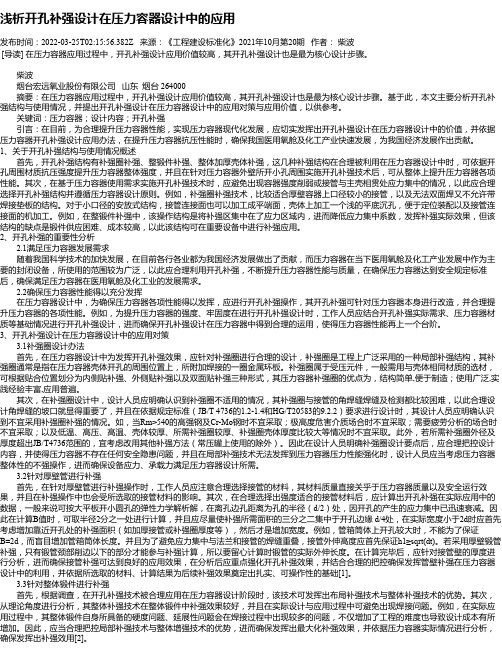
浅析开孔补强设计在压力容器设计中的应用发布时间:2022-03-25T02:15:56.382Z 来源:《工程建设标准化》2021年10月第20期作者:柴波[导读] 在压力容器应用过程中,开孔补强设计应用价值较高,其开孔补强设计也是最为核心设计步骤。
柴波烟台宏远氧业股份有限公司山东烟台 264000摘要:在压力容器应用过程中,开孔补强设计应用价值较高,其开孔补强设计也是最为核心设计步骤。
基于此,本文主要分析开孔补强结构与使用情况,并提出开孔补强设计在压力容器设计中的应用对策与应用价值,以供参考。
关键词:压力容器;设计内容;开孔补强引言:在目前,为合理提升压力容器性能,实现压力容器现代化发展,应切实发挥出开孔补强设计在压力容器设计中的价值,并依据压力容器开孔补强设计应用办法,在提升压力容器抗压性能时,确保我国医用氧舱及化工产业快速发展,为我国经济发展作出贡献。
1、关于开孔补强结构与使用情况概述首先,开孔补强结构有补强圈补强、整锻件补强、整体加厚壳体补强,这几种补强结构在合理被利用在压力容器设计中时,可依据开孔周围材质抗压强度提升压力容器整体强度,并且在针对压力容器外壁所开小孔周围实施开孔补强技术后,可从整体上提升压力容器各项性能。
其次,在基于压力容器使用需求实施开孔补强技术时,应避免出现容器强度削弱或接管与主壳相贯处应力集中的情况,以此应合理选择开孔补强结构并遵循压力容器设计原则。
例如,补强圈补强技术,比较适合厚壁容器上口径较小的接管,以及无法双面焊又不允许带焊接垫板的结构。
对于小口径的安放式结构,接管连接面也可以加工成平端面,壳体上加工一个浅的平底沉孔,便于定位装配以及接管连接面的机加工。
例如,在整锻件补强中,该操作结构是将补强区集中在了应力区域内,进而降低应力集中系数,发挥补强实际效果,但该结构的缺点是锻件供应困难、成本较高,以此该结构可在重要设备中进行补强应用。
2、开孔补强的重要性分析 2.1满足压力容器发展需求随着我国科学技术的加快发展,在目前各行各业都为我国经济发展做出了贡献,而压力容器在当下医用氧舱及化工产业发展中作为主要的封闭设备,所使用的范围较为广泛,以此应合理利用开孔补强,不断提升压力容器性能与质量,在确保压力容器达到安全规定标准后,确保满足压力容器在医用氧舱及化工业的发展需求。
- 1、下载文档前请自行甄别文档内容的完整性,平台不提供额外的编辑、内容补充、找答案等附加服务。
- 2、"仅部分预览"的文档,不可在线预览部分如存在完整性等问题,可反馈申请退款(可完整预览的文档不适用该条件!)。
- 3、如文档侵犯您的权益,请联系客服反馈,我们会尽快为您处理(人工客服工作时间:9:00-18:30)。
Mechanical Engineering and Technology 机械工程与技术, 2017, 6(2), 116-127 Published Online June 2017 in Hans. /journal/met https:///10.12677/met.2017.62017文章引用: 刘京东, 钱才富. 平板矩形大开孔结构补强设计及效果研究[J]. 机械工程与技术, 2017, 6(2): 116-127.Study of the Reinforcement Design and Effects on the Structure of a Plate with a Large Rectangular OpeningJingdong Liu, Caifu QianCollege of Mechanical and Electrical Engineering, Beijing University of Chemical Technology, BeijingReceived: May 23rd , 2017; accepted: Jun. 4th , 2017; published: Jun. 9th, 2017AbstractIn this paper, finite element method is applied to simulate the stress distribution at the structure of a plate with a large retangular opening under the transverse pressure with the concentration on the reinforcement methods and effects. It is found that the maximum stress occurs at the round corner ofthe nozzle at the opening and the stress is mainly the bending one. Unlike on a cylinder, a reinforcement ring is not effective to reinforce the plate with rectangular opening. By increasing the bending stiffness, adding the nozzle thickness or applying reinforcement ribs can effectively reinforce the strength of the plate with opening. Specifically, when the reinforcement ribs are parallel to the short edge of the nozzle at the opening and close to the round corner, the reinforcing effect is the most significant.KeywordsPlate with Opening, Reinforcement Design, Stress Analysis平板矩形大开孔结构补强设计及效果研究刘京东,钱才富北京化工大学,机电工程学院,北京收稿日期:2017年5月23日;录用日期:2017年6月4日;发布日期:2017年6月9日摘 要本文采用有限元法,模拟了带有矩形大开孔的平板在压力作用下的应力分布及特点,并研究了强度补强方法与补强效果,发现最大应力出现在大开孔接管圆弧拐角处,结构上的应力主要是弯曲应力;和圆筒体开孔结构不同,平板补强圈补强没有明显效果,甚至适得其反;而由于增加了结构的弯曲刚度,厚壁刘京东,钱才富管补强和加强筋补强都能有效降低开孔接管与平板连接处的应力集中,特别是当加强筋平行于短边并靠近开孔拐角布置时,补强效果最显著。
关键词平板开孔,补强设计,应力分析Copyright © 2017 by authors and Hans Publishers Inc.This work is licensed under the Creative Commons Attribution International License (CC BY)./licenses/by/4.0/1. 引言在压力容器的设计制造过程中,工艺要求开孔的情况不可避免。
由于开孔破坏了结构的连续性,压力容器在外载荷的作用下,会在开孔附近出现应力集中现象,降低了结构承载能力,因此开孔补强设计是压力容器设计过程中重要的组成部分。
本文所研究的高压氧舱舱门为平板中心矩形大开孔结构,其开孔率已超出GB150-2011中规定的范围,故不能采用等面积法进行设计校核[1]。
在HG/T20852-2011中阐述了基于压力面积法的大开孔补强计算,但其计算模型适用于开圆孔的壳体[2]。
对于大开孔问题,国内外学者采用有限元方法进行数值计算,但主要集中于圆形、长圆形或椭圆形大开孔,针对矩形大开孔的分析较为少见[3] [4] [5] [6]。
在工程实际中,常规的补强方法[7]包括厚壁接管补强、补强圈补强和加强筋补强。
就平板中心矩形大开孔结构,本文拟通过有限元模拟分析上述各补强结构在相同载荷作用下的响应,对比补强效果并得出对矩形大开孔最为有效的补强措施。
2. 计算模型的确定2.1. 平板矩形大开孔结构的简化及基本参数本文采用ANSYS15.0软件研究平板开孔附近的应力。
氧舱舱门结构为圆形平板正中心开矩形孔,并在开孔处接有舱门围栏(下称接管)。
根据其对称性,取整体结构的1/4进行建模。
不同补强结构的计算模型如图1~图4所示。
平板和接管材料均为Q345R,弹性模量E = 1.99 × 1011 Pa,泊松比u = 0.3。
几何结构的具体参数如表1所示。
2.2. 边界条件设置压力边界如下:1) 在平板内表面以及内伸接管外表面施加0.3 MPa的压力;2) 在内伸接管端面施加由内压引起的等效接管载荷,其值为4.75 MPa。
位移边界条件如下:在对称截面上施加对称约束,平板外边缘施加全约束。
2.3. 单元选用及网格无关性测试采用SHELL181单元划分网格。
SHELL181单元为具有4节点的结构单元,每个节点具有6个自由度适合对薄壳结构进行分析。
网格的划分需要进行网格无关性测试,即将结构网格细化。
在1.2所述边界条件下,以初始无任何补强结构典型部位的应力强度为依据进行结果比较,网格无关性测试见表2。
表2说明,初始总体网格刘京东,钱才富尺寸已具有足够精度,故应用于后面的数值模拟。
3. 有限元计算结果及对比分析3.1. 内压作用下结构无补强时的计算结果图5为结构上的薄膜加弯曲应力分布,云图中最大应力值(842 MPa)位于平板与接管的拐角连接处,应力集中区亦主要出现在该区域。
图6为结构上的薄膜应力分布,云图中薄膜应力最大值(142.2 MPa)也位于平板Table 1. Geometrical parameters表1. 几何结构的具体参数平板矩形大开孔结构结构尺寸圆平板直径D/mm 3216圆平板初始厚度t/mm 20圆平板上矩形孔尺寸/mm 1922 × 1222开孔处圆角尺寸/mm 192接管内接深度/mm 265接管初始壁厚/mm 22Table 2. Grid independence test表2. 网格无关性测试总体网格尺寸20 mm 总体网格尺寸10 mm 相对误差最大薄膜应力/MPa 142.3 145.5 2.2% 最大薄膜加弯曲应力/MPa 842.1 830.8 1.4%Figure 1. Geometric model of thick-walled reinforcement图1. 厚壁接管补强的几何模型刘京东,钱才富Figure 2. Geometric model of reinforcement ring图2. 补强圈补强的几何模型Figure 3. Geometric model of reinforcement ribs in vertical distribution图3. 加强筋竖直排列补强的几何模型刘京东,钱才富Figure 4. Geometric model of reinforcement ribs in horizontal distribution图4. 加强筋水平排列补强的几何模型Figure 5. Distribution of membrane plus bending stress intensity (MPa)图5. 薄膜加弯曲应力分布(MPa)刘京东,钱才富与接管的连接处,由此可知连接处的弯曲应力为主要成分。
原因在于受横向载荷(压力)作用时,平板主要发生弯曲变形。
此外,矩形大开孔破坏了结构的几何连续性,在连接处由于变形协调产生了局部弯曲应力。
为降低该局部弯曲应力,需要进行强度补强,本文采用的补强方法包括增加接管的厚度、设置加强圈、设置加强筋。
3.2. 内压作用下加厚接管补强的计算结果接管的初始厚度为22 mm,在此基础上增加接管厚度,每次增加1 mm,直至30 mm。
图7表示最大薄膜加弯曲应力随接管厚度的变化,最大值由加厚前的842 MPa降至352 MPa,补强效果明显。
图8为最大薄膜应力随接管厚度的变化,其最大值已由142 MPa下降至100 MPa。
所以,加厚接管是能有效降低平板开孔接管连接处的应力的,特别是弯曲应力,其原因是增加接管厚度增加了结构的弯曲刚度。
图9和图10分别为接管厚度为30 mm时结构上薄膜加弯曲应力分布和薄膜应力分布。
按应力分类所得各应力强度满足各自应力强度安全判据。
3.3. 内压作用下补强圈补强的计算结果补强圈与平板间的接触行为属于非线性问题,但有研究表明,在内压一定的条件下,有接触与无接触两种情况下最大应力相差不大[8],为提高计算效率,这里不考虑平板与补强圈之间的接触行为。
初始补强圈处总厚度设为21 mm,拟计算在不同接管壁厚情况下补强结构的应力。
图11为补强圈厚6 mm即补强圈处总厚度为26 mm时结构上薄膜加弯曲应力强度分布,可见采用补强圈补强,结构上的最大应力出现的位置没有改变。
图12为最大薄膜加弯曲应力强度随补强圈总厚度的变化。
图12表明,接管厚度一定时,结构连接处的薄膜加弯曲应力强度随补强圈处总厚度的增加先减少Figure 6. Membrane stress intensity distribution (MPa)图6. 薄膜应力分布(MPa)刘京东,钱才富Figure 7. Plots of membrane plus bending stress vs. nozzle thickness图7. 薄膜加弯曲应力随接管厚度的变化Figure 8. Plots of membrane stress vs. nozzle thickness图8. 薄膜应力随接管厚度的变化刘京东,钱才富Figure 9. Distribution of membrane plus bending stress intensity when the thickness is 30 mm (MPa)图9. 接管壁厚为30 mm时薄膜加弯曲应力分布(MPa)Figure 10. Plots of membrane stress vs. nozzle thickness图10. 薄膜应力随接管厚度的变化刘京东,钱才富Figure 11. Plots of membrane stress vs. nozzle thickness图11. 薄膜应力随接管厚度的变化Figure 12. Plots of membrane stress vs. nozzle thickness图12. 薄膜应力随接管厚度的变化刘京东,钱才富后增加,并且均是当补强圈处总厚度约大于接管厚度1 mm时,最大薄膜加弯曲应力强度取到最小值,而当补强圈厚度再增加时,薄膜加弯曲应力强度又稳定上升。
